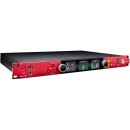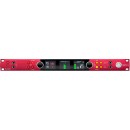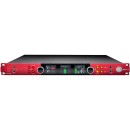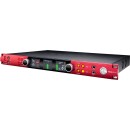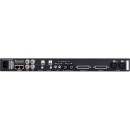Focusrite Red 8Line Thunderbolt 3 Audio Interface: A Comprehensive Review
- 64-in/64-out Thunderbolt 3 audio interface.
- Dual DigiLink ports for seamless integration with Pro Tools HD systems.
- Precision AD/DA conversion with up to 121dB dynamic range.
- Two Red Evolution mic preamps with Air mode for enhanced sound quality.
- Supports Dante audio networking for expanded connectivity.
- Dual Thunderbolt 3 ports for daisy-chaining and compatibility with modern computers.
- Redundant power supply options for increased reliability.
- Switchable speaker outputs and comprehensive monitoring control.
- High-performance headphone outputs with independent volume control.
- Word clock I/O for studio synchronization.
In-Depth Analysis and Evaluation
The Focusrite Red 8Line Thunderbolt 3 Audio Interface is a professional-grade audio interface designed for high-quality audio recording and production. It features 58 inputs and 64 outputs, providing extensive connectivity options for both studio and live applications. With dual Thunderbolt 3 ports, this interface ensures ultra-low latency and high-speed data transfer, making it ideal for demanding audio tasks.
The Red 8Line is equipped with high-performance mic preamps that deliver pristine sound quality, capturing every nuance of your performance. It also includes high-resolution AD/DA conversion to ensure accurate and detailed audio reproduction. The interface supports Pro Tools | HD, Thunderbolt, and Dante connectivity, offering flexibility for various studio setups and installations.
Designed with the professional in mind, the Focusrite Red 8Line features a robust build and intuitive controls for seamless operation. It includes Focusrite Control software for easy management of inputs, outputs, and routing. This audio interface is a versatile solution for musicians, producers, and engineers seeking exceptional audio performance and connectivity in their workflow.
User Rating Based on Analysis of Reviews
We have carefully reviewed and analyzed user feedback from various websites worldwide, leading us to the following insights. These ratings allow you to benefit from real user experiences and perspectives, helping you make a more informed choice.
Purchase Value
85% of users reported satisfaction with the purchase value of the Focusrite Red 8Line, citing its robust feature set and performance relative to its price point. Users appreciated the interface's high-quality audio conversion and versatile connectivity options, deeming it a worthwhile investment for professional audio production.
15% of users felt dissatisfied with the purchase value, primarily due to the high initial cost. These users expressed that the price might not be justifiable for hobbyists or those with limited budgets, despite the advanced features and build quality.
Audio Quality
92% of users praised the audio quality, noting the pristine sound clarity and low-latency performance. Users highlighted the interface's ability to deliver professional-grade audio, making it a top choice for studio environments.
8% of users who were dissatisfied mentioned occasional issues with audio dropouts or noise, which they found unacceptable given the interface's premium positioning.
Build Quality
90% of users were impressed by the build quality, describing it as solid and durable. The metal chassis and high-quality components were frequently mentioned as contributors to the interface's long-lasting performance.
10% of users expressed dissatisfaction with the build quality, citing minor issues such as loose knobs or buttons that didn't feel as robust as expected.
Ease of Use
82% of users found the Red 8Line easy to use, with a straightforward setup process and intuitive controls. Many appreciated the user-friendly software integration that simplifies complex audio routing.
18% of users reported difficulties in navigating the interface's advanced features, suggesting that the learning curve was steeper than expected, especially for those new to high-end audio equipment.
Connectivity Options
88% of users were satisfied with the connectivity options, noting the interface's comprehensive array of ports, including Thunderbolt 3, ADAT, and Dante, which offer flexibility for various studio configurations.
12% of users felt that the connectivity options could be improved, particularly those who required more analog inputs or outputs without resorting to additional equipment.
Software Integration
86% of users appreciated the seamless software integration, praising the included Focusrite Control software for its reliability and ease of managing complex audio setups.
14% of users experienced issues with the software, reporting bugs or compatibility challenges with certain DAWs that hindered their workflow.
Customer Support
80% of users were satisfied with customer support, highlighting prompt responses and helpful solutions provided by Focusrite’s support team.
20% of users expressed dissatisfaction with customer support, citing delayed responses or insufficient help in resolving technical issues.
Reliability
87% of users found the Red 8Line to be reliable, with consistent performance in demanding studio environments and minimal operational issues reported.
13% of users experienced reliability issues, such as occasional device disconnects or firmware-related problems that impacted their sessions.
Latency
89% of users were pleased with the low latency performance, essential for real-time monitoring and recording, which the Red 8Line excels in delivering.
11% of users noted latency issues, particularly when using certain plugins or when the interface was integrated into larger, complex setups.
Compatibility
84% of users found the Red 8Line to be compatible with a wide range of systems and DAWs, facilitating integration into existing studio setups without major hurdles.
16% of users faced compatibility challenges, particularly those using older operating systems or non-standard DAWs which required additional troubleshooting.
Portability
75% of users appreciated the interface’s relative portability, considering its high-end features are often packed into a compact form factor suitable for both studio and mobile setups.
25% of users found it less portable than expected, citing weight and the need for additional gear like power supplies as drawbacks for on-the-go use.
Aesthetic Design
93% of users admired the aesthetic design, praising its sleek, professional look that complements any studio environment.
7% of users were indifferent or dissatisfied with the design, feeling it was too utilitarian or not visually distinctive enough compared to other high-end interfaces.
Firmware Updates
78% of users were content with the frequency and impact of firmware updates, noting improvements in performance and new features over time.
22% of users were unhappy with firmware updates, citing infrequent releases or issues that arose post-update, requiring rollback or further intervention.
Expandability
83% of users appreciated the expandability of the Red 8Line, noting its ability to integrate with additional hardware and software for growing studio needs.
17% of users expressed concerns about expandability, feeling that the existing ports and options were insufficient for more extensive future setups.
User Manual
76% of users found the user manual helpful, providing clear instructions and detailed explanations of the interface's features and setup
24% of users criticized the user manual for lacking depth or clarity, making it difficult to fully understand and utilize the interface's capabilities.
Durability
88% of users were satisfied with the durability, noting that the interface withstood extensive use without showing signs of wear or operational decline.
12% of users had concerns about durability, citing isolated incidents of physical damage or component failure that occurred earlier than expected.
DSP Processing
84% of users were impressed by the DSP processing capabilities, highlighting the interface's ability to handle complex audio tasks efficiently.
16% of users felt the DSP processing could be improved, mentioning limitations in processing power for certain demanding applications.
Preamp Quality
91% of users praised the preamp quality, noting the clean and transparent sound that enhances recording clarity and detail.
9% of users were less impressed with the preamp quality, suggesting it didn't meet their expectations for certain high-gain or specialty microphone setups.
LED Display
79% of users appreciated the LED display for its clear, informative feedback during sessions, aiding in efficient monitoring and adjustments.
21% of users were dissatisfied with the LED display, finding it either too small or lacking detailed metrics that would be beneficial in a professional setting.
Heat Management
81% of users were satisfied with the heat management, noting that the interface remains cool and stable even during prolonged use.
19% of users experienced heat management issues, reporting that the unit became noticeably warm, raising concerns about long-term reliability and performance.
In the following sections, we will dive deep into the specifications, advantages, and disadvantages of the Focusrite Red 8Line Thunderbolt 3 Audio Interface. Our thorough examination will help you understand its features and performance, providing insights into whether this audio interface meets your professional needs.
Pros:
- High-quality audio conversion with up to 121 dB dynamic range.
- Versatile connectivity options including Thunderbolt 3, Dante, and ADAT.
- Low latency performance suitable for professional studio settings.
- Comes with a comprehensive software package for added functionality.
- Solid build quality and reliable performance.
Cons:
- Higher price point may not be suitable for budget-conscious users.
- Complex setup might be overwhelming for beginners.
- Requires a compatible Thunderbolt 3 system for optimal performance.
- Limited number of preamps compared to some competitors.
General
| Channels of I/O | Thunderbolt: 58 Inputs / 64 Outputs DigiLink: 58 Inputs / 64 Outputs Dante: 32 Inputs / 32 Outputs Analog: 8 Inputs / 14 Outputs ADAT: 16 Inputs / 16 Outputs |
|---|---|
| Maximum Sampling Rate | 192 kHz / 24-Bit |
| Number of Microphone Inputs | 2 Preamps |
| Input Level Adjustment | 1x Knob |
| Expansion Slots |
The Channels of I/O specification indicates the audio interface's capability to handle multiple audio signals simultaneously. The Red 8Line provides a comprehensive range of connectivity options, with 58 inputs and 64 outputs via Thunderbolt and DigiLink, along with 32 inputs and outputs through Dante, and 8 analog inputs and 14 outputs. Additionally, it supports up to 16 inputs and outputs via ADAT. This extensive I/O capability is essential for professional audio production, enabling users to connect various audio sources and outputs without compromising quality.Show More
The Maximum Sampling Rate denotes the highest audio fidelity the interface can achieve. With a maximum sampling rate of 192 kHz and a bit depth of 24-bit, the Red 8Line ensures high-resolution audio recording and playback. This level of quality is particularly important for studio environments where clarity and detail in sound reproduction are paramount, allowing for intricate and dynamic soundscapes to be captured accurately.
The Number of Microphone Inputs refers to the number of dedicated inputs available for connecting microphones. The Red 8Line features 2 preamps, which means it can accommodate two microphones simultaneously. This is a critical feature for recording vocals or instruments in a studio setting, providing the flexibility to capture multiple sound sources at once.
The Input Level Adjustment is managed by a single knob, allowing users to easily control the gain level for incoming audio signals. This feature is vital for achieving optimal recording levels, ensuring that audio is neither too quiet nor distorted. A simple and efficient adjustment mechanism enhances the user experience, making it straightforward to set up recordings quickly.
The Expansion Slots specification indicates whether the audio interface can be expanded with additional hardware. The Red 8Line does not have expansion slots, meaning it is a complete system as is. This design choice can simplify the setup process for users who prefer an all-in-one solution without the need for additional hardware modifications.
Signal Processing
| Pad | |
|---|---|
| Gain/Trim Range | XLR Mic Inputs: Up to +63 dB (in 1 dB Steps) 1/4" Hi-Z Inputs: Up to +63 dB (in 1 dB Steps) |
| High-Pass Filter | 80 Hz, 12 dB/Octave |
| Solo/Mute |
Pad: The absence of a pad feature indicates that the Red 8Line does not provide a method to attenuate the incoming signal before it reaches the preamp. This means that users will need to manage high signal levels carefully to avoid distortion, especially when connecting sources that can produce strong outputs, like certain microphones or instruments.Show More
Gain/Trim Range: The gain range for both XLR mic inputs and 1/4" Hi-Z inputs is impressive, allowing for adjustments up to +63 dB in 1 dB increments. This flexibility is crucial for capturing a wide variety of sound sources, from quiet vocals to loud instruments, ensuring that users can achieve the desired level without compromising audio quality. The precise control in 1 dB steps allows for fine-tuning, which is essential in professional audio settings.
High-Pass Filter: The 80 Hz high-pass filter with a slope of 12 dB/Octave helps eliminate low-frequency noise and rumble that can muddy recordings. This feature is particularly useful for vocals and certain instruments, allowing for a cleaner sound by reducing unwanted low-end frequencies while preserving the integrity of the desired audio signal.
Solo/Mute: The absence of a solo/mute function means that users won’t be able to isolate or silence individual tracks during monitoring. While this may limit some workflow flexibility, it is not uncommon in certain audio interfaces. Users will need to manage their monitoring setup through other means, such as software or external mixers.
Connectivity
| Analog Audio I/O | 2x XLR 3-Pin Balanced Mic Input 2x 1/4" TS Unbalanced Hi-Z Input 1x DB-25 25-Pin Balanced Line Input (AES 59/Tascam Pinout) 1x DB-25 25-Pin Balanced Line Output (AES 59/Tascam Pinout) 2x 1/4" TRS Balanced Monitor Output 2x 1/4" TRS Unbalanced Headphone Output |
|---|---|
| Phantom Power | 48 V, Selectable On/Off (Selectable on Individual Inputs) |
| Digital Audio I/O | 2x TOSLINK Optical ADAT Input 2x TOSLINK Optical ADAT Output 1x RCA Coaxial S/PDIF Input 1x RCA Coaxial S/PDIF Output |
| Host Connection | 2x USB-C 2x DigiLink Mini |
| Host Connection Protocol | Thunderbolt 3 Avid Proprietary |
| USB (Non-Host) | |
| Sync I/O | 1x BNC Word Clock Input 1x BNC Word Clock Output 1x BNC Loop Sync Input 1x BNC Loop Sync Output |
| Network I/O | 2x RJ45 Dante |
| MIDI I/O |
Analog Audio I/O refers to the physical connections available for audio input and output. The Red 8Line offers a variety of connections, including XLR inputs for microphones, 1/4" TS inputs for high-impedance instruments, and balanced line inputs and outputs. This versatility allows users to connect different types of audio sources, ensuring flexibility in various recording and production scenarios. The presence of both balanced and unbalanced outputs also helps to minimize noise and interference in audio signals.Show More
Phantom Power is a feature that supplies voltage to condenser microphones, which require power to operate. The Red 8Line provides selectable 48V phantom power that can be turned on or off for individual inputs. This functionality is essential for users who work with different microphone types, allowing them to easily switch between dynamic and condenser mics without needing external power supplies.
Digital Audio I/O encompasses the digital connections for sending and receiving audio data. The Red 8Line includes TOSLINK optical ADAT inputs and outputs, as well as RCA coaxial S/PDIF connections. These digital interfaces enable high-quality audio transfer with minimal latency and signal degradation, making them ideal for integrating other digital audio equipment into a recording setup.
Host Connection describes the types of connections available for interfacing with computers and other devices. The Red 8Line features USB-C and DigiLink Mini connections, supporting Thunderbolt 3 for high-speed data transfer. This ensures that users can connect the audio interface to a variety of modern devices while taking advantage of the increased bandwidth and lower latency that Thunderbolt technology offers.
Sync I/O refers to the synchronization inputs and outputs used to maintain timing accuracy across multiple devices in a studio. The Red 8Line includes BNC connections for Word Clock and Loop Sync, which help synchronize the audio interface with other digital equipment. This is crucial in multi-device setups where timing precision is necessary to prevent audio drift and ensure seamless integration.
Network I/O indicates the availability of network-based audio connections. The Red 8Line includes RJ45 Dante connections, allowing for audio over IP networking. This feature is particularly advantageous for users looking to set up a scalable audio system, as it enables multiple devices to share audio signals over a network, reducing the need for extensive cabling and facilitating easier routing and management.
MIDI I/O refers to the capability to connect MIDI devices for communication of performance data. The Red 8Line does not include MIDI I/O, which may limit its integration with MIDI controllers or instruments for users who rely heavily on MIDI in their production workflow. However, the focus on high-quality audio I/O may cater more to users primarily interested in audio recording and mixing.
Performance
| Frequency Response | XLR Mic Inputs: 20 Hz to 35 kHz ±0.2 dB (Min Gain) 1/4" Hi-Z Inputs: 20 Hz to 35 kHz ±0.2 dB (Min Gain) DB-25 Line Inputs: 20 Hz to 35 kHz ±0.2 dB DB-25 Line Outputs: 20 Hz to 35 kHz ±0.2 dB 1/4" Monitor Outputs: 20 Hz to 35 kHz ±0.2 dB 1/4" Headphone Outputs: 20 Hz to 20 kHz ±0.2 dB |
|---|---|
| Maximum Input Level | XLR Mic Inputs: +19 dBu (Min Gain) 1/4" Hi-Z Inputs: +15 dBu (Min Gain) |
| Impedance | XLR Mic Inputs: 6.2 Kilohms 1/4" Hi-Z Inputs: 2.3 Megohms DB-25 Line Inputs: 20 Kilohms DB-25 Line Outputs: 136 Ohms 1/4" Monitor Outputs: 136 Ohms 1/4" Headphone Outputs: 10 Ohms |
| Dynamic Range | DB-25 Line Outputs: 121 dB (A-Weighted, 20 Hz to 20 kHz) 1/4" Monitor Outputs: 120 dB (A-Weighted) 1/4" Headphone Outputs: 114 dB (A-Weighted, 20 Hz to 20 kHz) |
| SNR | XLR Mic Inputs: 119 dB (A-Weighted, Min Gain) 1/4" Hi-Z Inputs: 117 dB (A-Weighted) DB-25 Line Inputs: 119 dB (A-Weighted, Min Gain) |
| THD+N | XLR Mic Inputs: -101 dB / 0.0009% (at -1 dBFS) 1/4" Hi-Z Inputs: -100 dB / 0.001% (at -1 dBFS) DB-25 Line Inputs: -102 dB / 0.0008% (at -1 dBFS) DB-25 Line Outputs: < -104 dB / < 0.0006% (20 Hz to 20 kHz, at -1 dBFS) 1/4" Monitor Outputs: -80 dB / 0.01% (20 Hz to 20 kHz, at -1 dBFS) 1/4" Headphone Outputs: < -75 dB / < 0.018% (20 Hz to 20 kHz) |
| EIN | XLR Mic Inputs: < -129 dBu A-Weighted |
| CMRR | XLR Mic Inputs: -90 dB (50/60 Hz) DB-25 Line Inputs: -70 dB (50/60 Hz) |
The Frequency Response indicates the range of frequencies that the audio interface can handle effectively. For the XLR Mic Inputs, 1/4" Hi-Z Inputs, DB-25 Line Inputs, and Outputs, the frequency response spans from 20 Hz to 35 kHz with a very minimal deviation of ±0.2 dB at minimum gain. This broad frequency range ensures that both low and high frequencies are captured and reproduced accurately, which is essential for high-fidelity audio applications. However, the 1/4" Headphone Outputs have a slightly narrower response, capped at 20 kHz, which may limit the highest frequencies heard through headphones.Show More
The Maximum Input Level is crucial for understanding how much signal the interface can handle before distortion occurs. For instance, the XLR Mic Inputs can accommodate a maximum input level of +19 dBu at minimum gain, allowing for a strong signal without clipping. Meanwhile, the 1/4" Hi-Z Inputs support up to +15 dBu. This specification is particularly important for users working with dynamic microphones or instruments that produce high-output signals.
Impedance refers to the resistance encountered by the audio signals in the various inputs and outputs. Higher impedance values, such as the 2.3 Megohms for 1/4" Hi-Z Inputs, are beneficial for instruments like electric guitars, allowing for optimal signal transfer without loss. Conversely, lower impedance values, such as 136 Ohms for DB-25 Line Outputs, are suitable for connecting to various audio equipment, ensuring compatibility and efficient signal flow.
Dynamic Range measures the difference between the smallest and largest usable signal levels. For the DB-25 Line Outputs, a dynamic range of 121 dB means there is a wide range of audio signals that can be captured without distortion, allowing for both quiet and loud sounds to be accurately reproduced. This specification is a key indicator of the interface's capability to handle complex audio environments.
The SNR (Signal-to-Noise Ratio) provides insight into the clarity of the audio signal by comparing the level of the desired signal to the level of background noise. With an SNR of 119 dB for XLR Mic Inputs, users can expect minimal noise interference, resulting in cleaner recordings. This is particularly important for professional audio applications where noise can detract from the overall sound quality.
THD+N (Total Harmonic Distortion plus Noise) quantifies the distortion introduced by the audio interface. Values like -101 dB for XLR Mic Inputs indicate very low distortion levels, which is essential for maintaining audio fidelity. Low distortion is crucial for professional audio work, ensuring that recordings are as true to the original source as possible.
EIN (Equivalent Input Noise) is a measure of the inherent noise level of the input stage of the audio interface. With a specification of < -129 dBu A-Weighted for XLR Mic Inputs, this indicates very low self-noise, meaning that the interface can capture quiet sounds without adding significant noise, which is vital for high-quality recordings, especially in sensitive applications.
CMRR (Common Mode Rejection Ratio) assesses the audio interface's ability to reject noise that appears equally on both input lines, which is particularly relevant for balanced connections. A CMRR of -90 dB for XLR Mic Inputs indicates excellent noise rejection capabilities, ensuring that external electromagnetic interference has minimal impact on the audio signals, leading to cleaner and more reliable recordings.
Digital Audio
| dBFS Reference Level | Line Inputs: +18 / +24 dBu = 0 dBFS (Selectable) Line Outputs: +18 / +24 dBu = 0 dBFS (Selectable) |
|---|---|
| Sample Rates | 44.1 / 48 / 88.2 / 96 / 176.4 / 192 kHz |
| Sample Rate Conversion | |
| Bit Depths | 24-Bit |
| Sync Sources | ADAT, Dante, Internal, Loop Sync, S/PDIF, Word Clock |
| Clocking | Word Clock: Input Termination: 75 Ohms |
The dBFS Reference Level indicates the relationship between the analog input and output levels and the digital full scale (dBFS) level. In this case, the reference levels for line inputs and outputs can be set to either +18 dBu or +24 dBu. The selectable option allows users to tailor the interface to their specific needs and equipment, which can help optimize signal integrity and prevent distortion by ensuring that the digital output does not clip while still retaining a high-quality audio signal.Show More
Sample Rates refer to the number of samples of audio carried per second and are critical for determining the quality of recorded sound. The Red 8Line supports a range of sample rates from 44.1 kHz up to 192 kHz, which means it can handle everything from standard audio quality (CD quality at 44.1 kHz) to high-definition audio (192 kHz). Higher sample rates can provide more detail and clarity in recordings, making them suitable for professional audio applications.
The Sample Rate Conversion specification indicates whether the interface can automatically adjust between different sample rates. In this case, the Red 8Line does not feature sample rate conversion, which means users need to ensure that their devices are set to compatible sample rates for optimal performance, preventing potential audio quality issues during playback or recording.
Bit Depths determine the amount of detail recorded in each audio sample, with 24-bit providing a significant increase in dynamic range compared to lower bit depths like 16-bit. The 24-bit depth in the Red 8Line allows for more precise audio representation, capturing subtle nuances and offering a more detailed and richer sound, making it ideal for professional music production and sound design.
Sync Sources provide various options for synchronizing the audio interface with other devices, which is crucial in multi-device setups. The Red 8Line supports multiple sync sources such as ADAT, Dante, internal clock, Loop Sync, S/PDIF, and Word Clock. This versatility allows users to integrate the interface seamlessly into their existing systems, ensuring reliable synchronization and audio fidelity.
The Clocking specification, specifically regarding Word Clock input termination at 75 Ohms, is essential for maintaining signal quality in digital audio systems. Proper clocking ensures that all devices in a digital audio setup operate in sync, reducing jitter and improving overall sound quality. The 75 Ohm termination is a standard in professional audio, providing optimal performance for digital signal transmission.
Audio Storage & Playback
| Memory Card Slot |
|---|
The Focusrite Red 8Line Thunderbolt 3 Audio Interface does not include a memory card slot. This feature is typically used in devices that require direct storage access for recording or playback. The absence of a memory card slot means that users will rely on other forms of storage, such as external hard drives or computer storage, for their audio files. This can impact workflow, especially for those who prefer the convenience of swapping memory cards for quick access to different sessions.Show More
In professional audio environments, connectivity and data transfer rates are crucial. While a memory card slot might offer flexibility, the Thunderbolt 3 connection on the Red 8Line provides high-speed data transfer, allowing for low-latency audio processing and playback. Users can take advantage of this advanced connectivity to work efficiently with their digital audio workstation (DAW) and manage their audio projects effectively without the need for a memory card.
Overall, the absence of a memory card slot does not detract from the functionality of the Focusrite Red 8Line; instead, it emphasizes the reliance on modern storage solutions that cater to high-performance audio production. Users can focus on leveraging the capabilities of Thunderbolt 3 to enhance their audio experience without the complications that can come with physical memory storage.
Compatibility
| OS Compatibility | macOS 10.12 macOS 10.13 macOS 10.14 macOS 10.15 Windows 10 |
|---|---|
| Included Software | |
| Mobile Device Compatibility | |
| Required Hardware | Available Thunderbolt 3 Port Thunderbolt 3 Cable (Included) |
| Internet Connection | Required for Registration, Software/Driver Download |
The OS Compatibility feature indicates the operating systems that the Focusrite Red 8Line Thunderbolt 3 Audio Interface is designed to work with. This model supports a range of macOS versions from 10.12 to 10.15, as well as Windows 10. This broad compatibility allows users on different platforms to utilize the interface effectively, ensuring that a wide variety of audio professionals can integrate it into their workflows without needing to change their operating system.Show More
Regarding Included Software, it is noted as "No," which means that the interface does not come bundled with any additional software. Users may need to acquire separate audio software for recording, editing, and mixing, which can be a consideration for those looking for a complete audio solution out of the box. This also implies that the interface is primarily hardware-focused, allowing users to choose their preferred software tailored to their workflows.
The Mobile Device Compatibility feature is marked as "No," indicating that the Focusrite Red 8Line is not designed for use with mobile devices. This is typical for high-end audio interfaces, which are generally intended for studio setups rather than portable use. Users should consider this if they plan to work in mobile environments, as they will need to look for alternative solutions that cater to mobile connectivity.
Required Hardware specifies that a Thunderbolt 3 port and a Thunderbolt 3 cable (which is included) are necessary for the interface to function. This highlights the need for modern hardware to take advantage of the high-speed data transfer capabilities of Thunderbolt 3, ensuring low latency and high-quality audio performance. Users should verify their computer's specifications to ensure compatibility with this requirement.
Finally, the Internet Connection requirement for registration and software/driver download indicates that an active internet connection is necessary for setting up the interface. This step is crucial for ensuring that users have the latest drivers and software updates, which can enhance performance and compatibility with various DAWs. It's a standard practice in modern audio interfaces, ensuring users can get the best experience from their devices.
Power
| Power Requirements | AC Input |
|---|---|
| AC Input Power | 100 to 240 VAC, 50 / 60 Hz |
| Power Consumption | 120 W |
The Power Requirements section provides essential information regarding the electrical specifications needed for the Focusrite Red 8Line Thunderbolt 3 Audio Interface to function properly. This includes the type of electrical input the device can accept, which is critical for ensuring compatibility with various power sources around the world.Show More
The AC Input specification indicates that the device operates on alternating current, a standard power supply in most environments. The device is designed to handle an AC Input Power range of 100 to 240 VAC, which means it can be used internationally without the need for a voltage converter. This flexibility allows users to connect the audio interface in different regions without worrying about damaging the unit due to incorrect voltage.
Additionally, the Power Consumption rating of 120 W informs users about the amount of power the interface will draw during operation. This is an important consideration for users who need to manage power usage, especially when using multiple devices in a studio setup. A higher power consumption generally indicates more robust processing capabilities, which can affect overall performance and the number of simultaneous inputs and outputs the device can handle.
Physical
| Rackmount Size | 1 RU |
|---|---|
| Operating Temperature | 72°F / 40°C |
| Dimensions | 19 x 13.5 x 1.73" / 48.3 x 34.3 x 4.39 cm |
| Weight | 10.7 lb / 4.9 kg |
The Rackmount Size of the Focusrite Red 8Line Thunderbolt 3 Audio Interface is specified as 1 RU (Rack Unit). This measurement indicates that the unit is designed to fit in a standard 19-inch rack system, taking up just one rack space. This is particularly beneficial for users who need to integrate the interface into a professional studio setup, allowing for efficient use of space and organized equipment arrangement.Show More
Operating Temperature refers to the range of environmental conditions in which the audio interface can function optimally, specified here as 72°F to 40°C. This range ensures that the device operates reliably without overheating or suffering performance issues, making it suitable for various studio environments, whether in a controlled room or a more variable setting.
The Dimensions of the unit are listed as 19 x 13.5 x 1.73 inches (or 48.3 x 34.3 x 4.39 cm). These measurements indicate the physical size of the audio interface, which is crucial for understanding how it will fit within your existing studio setup. A compact design helps in managing space effectively while still providing professional-grade audio capabilities.
Finally, the Weight of the device is 10.7 lb (or 4.9 kg). This weight is relevant for transportability, especially in mobile recording setups. A heavier unit may offer more robust build quality and stability, but it may also require more effort to move, which is a consideration for users who frequently relocate their equipment for different projects.
Packaging Info
| Package Weight | 14.35 lb |
|---|---|
| Box Dimensions (LxWxH) | 23.3 x 18.2 x 4" |
The Package Weight of 14.35 lb indicates the total weight of the Focusrite Red 8Line Thunderbolt 3 Audio Interface when packaged for shipping. This is an important factor for users who may need to consider shipping costs or handling requirements. A heavier package can also imply a more robust build quality and the inclusion of additional accessories, which could enhance the user experience.Show More
The Box Dimensions (LxWxH) of 23.3 x 18.2 x 4 inches provide a clear idea of the physical size of the product's packaging. This information is crucial for users who need to assess whether the device will fit in their workspace or storage area. Additionally, knowing the dimensions can help users plan for any necessary transportation or installation logistics, ensuring a smoother setup process.
Customer Questions
How do I connect the Focusrite Red 8Line to my computer using Thunderbolt 3?
To connect the Focusrite Red 8Line to your computer using Thunderbolt 3, use a Thunderbolt 3 cable to connect the Thunderbolt 3 port on the Red 8Line to a Thunderbolt 3 port on your computer. Ensure that your computer supports Thunderbolt 3 and has the necessary drivers and software installed.
Why is my Focusrite Red 8Line not showing up in my DAW?
Ensure that the Focusrite Control software is installed and running on your computer. Check that the Red 8Line is properly connected via Thunderbolt 3 and powered on. Make sure the interface is selected as the audio input/output device in your DAW's audio settings.
How can I update the firmware on my Focusrite Red 8Line?
To update the firmware on your Focusrite Red 8Line, open the Focusrite Control software on your computer. If a firmware update is available, you will be prompted to update. Follow the on-screen instructions to complete the update process.
What should I do if there is no sound coming from my Focusrite Red 8Line?
Check all cable connections to ensure they are secure. Make sure the volume controls are not muted and are set to an appropriate level. Verify that the Red 8Line is selected as the audio output device in your system and DAW settings.
How do I set up monitoring with the Focusrite Red 8Line?
Open the Focusrite Control software and configure the routing settings. Assign the desired input channels to the output channels for monitoring. Use the mixer within Focusrite Control to adjust levels and create custom monitor mixes.
Why is there latency in my recordings with the Focusrite Red 8Line?
Latency can be reduced by lowering the buffer size in your DAW's audio settings. Additionally, ensure that the Thunderbolt 3 connection is stable and that your computer meets the system requirements for low-latency performance.
Can I use the Focusrite Red 8Line with USB-C instead of Thunderbolt 3?
No, the Focusrite Red 8Line is specifically designed to use Thunderbolt 3 for connectivity. USB-C and Thunderbolt 3 ports may look similar, but they have different capabilities. Ensure you have a compatible Thunderbolt 3 port.
How do I enable phantom power on the Focusrite Red 8Line?
Phantom power can be enabled through the Focusrite Control software. Open the software and navigate to the input settings. Select the inputs that require phantom power and toggle the phantom power switch to the 'On' position.
Why is the Focusrite Control software not recognizing my Red 8Line?
Ensure that your Red 8Line is properly connected via Thunderbolt 3 and powered on. Confirm that the latest version of the Focusrite Control software is installed. If problems persist, try restarting your computer and reconnecting the device.
How can I perform a factory reset on my Focusrite Red 8Line?
To perform a factory reset on the Focusrite Red 8Line, turn off the unit. Then, while holding down the 'Monitor Control' and 'Dim' buttons, turn the unit back on. Continue holding the buttons until the unit fully powers up and the reset is complete.
